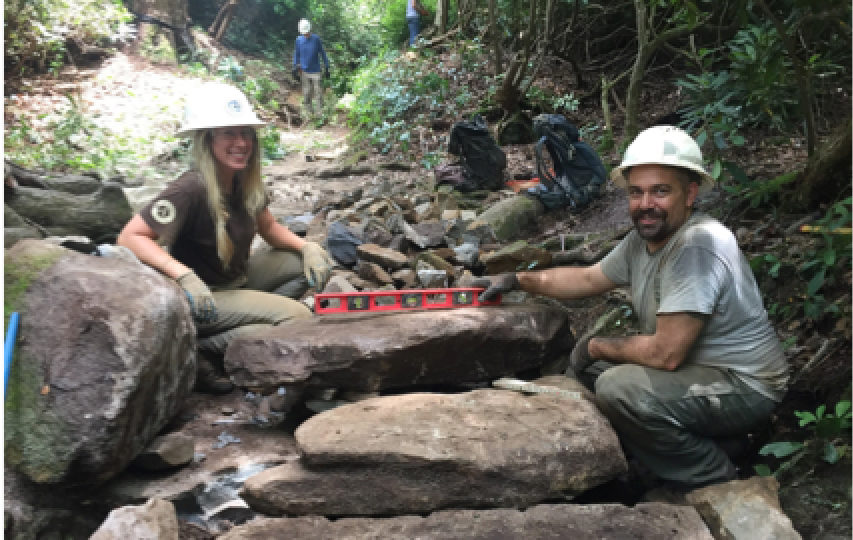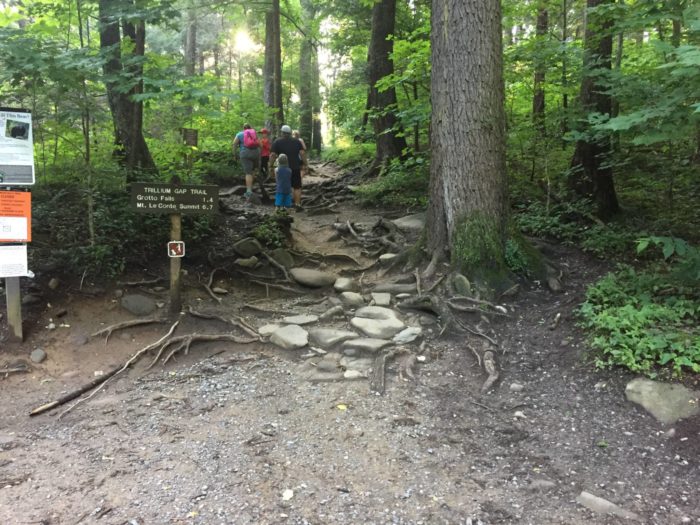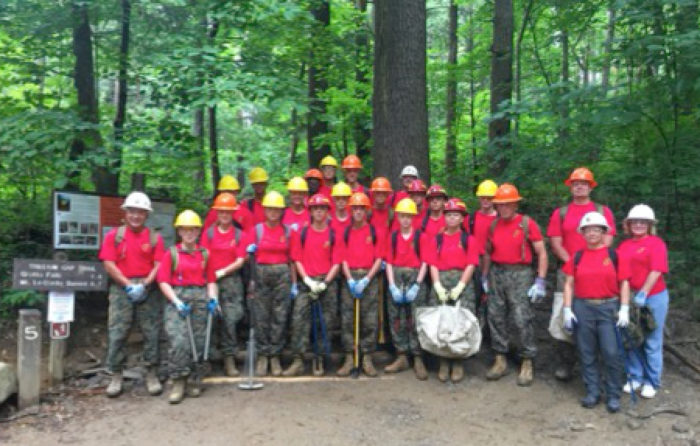by Julie Dodd
Work is underway on the restoration of the Trillium Gap Trail, with work being completed by the Trails Forever crew funded by Friends of the Smokies.
Trillium Gap Trail is one of the most popular hikes in the Great Smoky Mountains National Park, leading to Grotto Falls and to Mt. Le Conte.
Trillium Gap is the fifth major trail restoration taken on by the Trails Forever crew. Previously, the crew has restored Rainbow Falls Trail, Alum Cave Trail, Chimney Tops Trail and Forney Ridge Trail.
In 2018, more than 11.4 million people visited GSMNP. Many of them were making their first trip to the park and taking their first hikes. The Trails Forever trail work helps make the Park’s most popular trails more accessible and safer.
Josh Shapiro is the Trails Forever Crew Supervisor and has worked on the four previous trail restorations. I asked him to talk about the Trillium Gap Trail project.
FOTS: What was involved in planning for the Trillium Gap Trail restoration?

Josh Shapiro: We first had to survey the trail and identify trail deficiencies. This was a collaborative effort with trails staff in the park. We then met with GRSM Natural Resource Management staff to look at ways to best protect park resources along the trail.
We then came up with a materials and tool list that we will need for individual project sites and for the project at large. This included locust logs (to build trail structures), fill material, equipment, tools, supplies, etc.
We had locust logs flown to Mt. Le Conte by helicopter and transported to lower sections by the NPS Mule Team.
FOTS: What are some of the major goals for restoring this trail?
Josh Shapiro: The major goals of the project are to make the trail more sustainable, limit erosion, protect park resources, and to make the trail safer for hikers.
FOTS: What is the timeline for the restoration work?
Josh Shapiro: We have two seasons to complete the rehabilitation work — 2019 and 2020.
FOTS: Trillium Gap Trail is used by the llamas that carry supplies to LeConte Lodge. How is the restoration work affecting the llamas?
Josh Shapiro: The llamas are using the trail during the closure. They typically depart on the trail for LeConte Lodge before we arrive and return to the trailhead after we have already left for the day.
FOTS: How many workers are involved in the trailwork?
Josh Shapiro: We have a 9-person NPS Trail Crew and an 8-person ACE (American Conservation Experience) crew working on the trail full time. We also have volunteers and volunteer groups every Wednesday.
FOTS: What is the role of volunteers in doing trail restorations?
Josh Shapiro: Like all of our other full-scale trail rehabilitation projects (Forney Ridge, Chimney Tops, Alum Cave and Rainbow Falls), volunteers have a vital role in assisting the crews with the rehabilitation of Trillium Gap Trail.
Volunteers help with repairing trail tread (rock and root removal), constructing trail drainage, installing signs, collecting fill for trail structures (staircases, retaining walls turnpikes, etc.), assisting crew with building trail structures, cutting back vegetation to widen the trail corridor, rehabilitating social trails and damaged areas, and assisting the crew in many other work tasks.
Our crew has been fortunate to have had such hard working and enthusiastic volunteers.
***
 Learn more about how you can be a Wednesday volunteer with the Trails Forever crew.
Learn more about how you can be a Wednesday volunteer with the Trails Forever crew.
Friends of the Smokies established the Trails Forever endowment in 2012, thanks to a matching gift from the Aslan Foundation in Knoxville.
Today, the endowment has grown to more than $6 million and funds a full-time trail crew in Great Smoky Mountains National Park to reconstruct and rehabilitate some of the park’s most impacted trails.
Learn more about contributing to the Trails Forever endowment.




